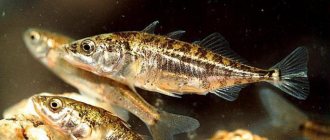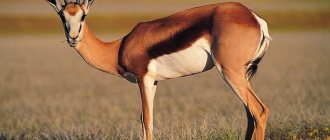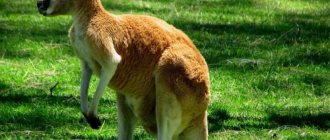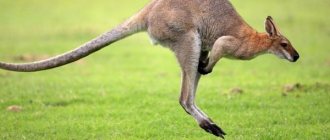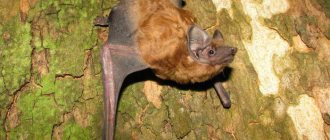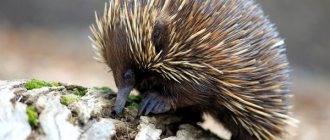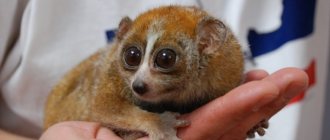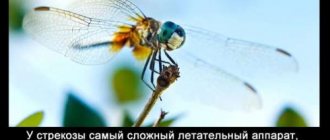Animals such as beavers are known to absolutely every person. Beavers are large rodents; they are the only representatives of the animal world from the order of rodents who can build their homes in water - dams.
The word “beaver” itself comes from the Proto-Indo-European language. Zoologists believe that the rodent first appeared in Asia; it was there that a huge number of fossilized remains of beavers dating back to the Eocene were found.
Beavers today live throughout Europe and Asia, found mainly in countries such as France, Germany, the Russian Federation, Mongolia and China.
№6
They are monogamous animals. They remain with their partner for life or until he dies. Beavers mate from January to February. Offspring appear approximately in April-June. The average length of pregnancy for a female of the American species is 130 days. For European countries - 107 days.
Young beavers do not leave their huts during the first month of life. Afterwards, they stay with their parents for at least 2 years, and help them maintain the hut in good condition.
Interesting facts about beavers
Beavers
– born builders and the only representatives of wild nature capable of influencing environmental conditions and changing it to suit their needs. However, most people know quite little about them. This is a serious omission, because there are many interesting secrets associated with beavers. Especially for the curious, we tried to select in one article the most little-known facts related to these amazing animals.
- The beaver's homeland is Asia. Fossil remains are found there dating back to the period called the Eocene;
- In Europe, the beaver is the largest rodent. In the world, it takes an honorable second place right after the capybara;
- The ancient beavers were simply monstrous. The found remains allowed scientists to create a computer model. This creature weighed 350 kg with a height of 275 cm;
- Today, only 2 species of beaver are known: common and Canadian;
- Not all beavers are brown. Sometimes there are characters with black fur;
- In water, their eyes are covered by the third eyelid - this is how they protect the organs of vision from debris floating with the flow;
- These rodents swim using webbed feet. The tail, contrary to popular belief, participates in this process not as a mover, but as a rudder;
- The tail has many purposes: a temperature regulator, a rudder when swimming and a storehouse for fat. And these fluffies hit the water with them. This is how they give each other an alarm signal;
- In order not to overheat in the summer, the beaver dips its tail in water, which cools it. Thanks to the large accumulation of vessels and capillaries in this part of the animal’s body, the blood cools and, in an already cooled form, spreads throughout the body, lowering its temperature;
- Of all the rodents, only these build dams in water;
- Their dams have an impressive margin of safety and can withstand very heavy loads;
- These rodents do not teach their children how to build. They know from birth what and how to do. Information is transmitted genetically;
- Beavers build dams to expand their habitat. They do not stray far from the water and in such a simple way arrange floods in order to be able to develop new territories;
- The average beaver can easily cut down 100 trees and build 50 dams during its lifetime;
- And cases where the length of the dams built by these creatures was 700 meters. The absolute record belongs to a structure 1,200 meters long, which was located in the state of New Hampshire;
- In order for the dams to be so strong, beavers use stones to strengthen the structures. Cobblestones are carried in the front paws to the desired location;
- To fell a tree with a trunk diameter of 7cm, a toothbrush will need 5 minutes. But with a 40 cm barrel it takes about 10 hours;
- These rodents have highly developed jaw muscles. They allow them to wear down even the hardest trees;
- There are cases when beavers die from a falling tree, which they themselves undermined.
- There is a known case when this animal was able to knock down a tree whose trunk diameter was about a meter;
- These animals produce a special secretion that gives their fur a water-repellent effect;
- The large lung capacity allows beavers to hold their breath for 15 minutes. This is enough for the tailed beast to swim about 700 meters;
- The Latin word for beaver is Castor. Now it’s clear where the name “castor oil” came from?
- Due to constant work, their teeth wear down very quickly. But they grow no slower: about half a centimeter per month;
- Beavers don't eat meat. They prefer the bark and shoots of trees, as well as reeds, reeds, water lilies and many other aquatic plants;
- Despite their small ears, these animals have acute hearing. With its help, they determine where the dam is leaking. Changing the tone of the noise of water passing between the branches provides them with all the necessary information;
- Beaver is very popular. It is found on Swedish, Polish, Russian, French, Swiss, German and German coats of arms;
- Beaver skins are more valuable than fox skins. And at one time they were used as money in Canada;
- These rodents are nocturnal animals. The period of their main life activity occurs at dusk and night;
- The tailed animals have a matriarchal social system. The female is the main one;
- During the construction of housing, beavers have reached such heights that they are warm even in the most severe frosts;
- One beaver litter can contain from 1 to 6 cubs;
- They reach adulthood by 2 years. It is then that animals start families;
- The territory that is “assigned” to one family is approximately 3 km2. Its boundaries are marked by a secretion with a pungent odor, which is called “beaver stream”;
- Beaver stream is a very important component used to create perfumes;
- There are 2 beaver monuments in Bobruisk. And the name of the city, as it were, hints after whom it was named;
- Philologists do not stop zealously debating which is correct – “beaver” or “beaver”. For now, a compromise option was chosen and it was decided that both words were true.
0 0
Add a comment
Reproduction and young
Beavers are monogamous animals, but if their partner dies, they find a replacement. The first estrus in females usually begins at the end of December, the peak of the mating season is in January. The female has 2-4 heats per season, each lasting 12-24 hours. Mating most often occurs in water, but is also possible in the den, and lasts up to 3 minutes.
Pregnancy takes 104-111 days, 3-4 puppies are born in one litter. Newborn beaver cubs are well prepared for life; they are born with full fur and open their eyes within a few days. Males take part in raising offspring together with females. The mother usually takes primary care of the cubs, while the father defends the territory and forages for food. Older beavers from previous litters also help with the babies.
Beavers spend the first 1-2 months in the den. At this time, the parents regularly change the grass bedding for the cubs, and together with the older offspring, bring food to the young animals. The mother feeds the cubs with breast milk for 1-2 months, but already at the age of 1 week, the beavers begin to eat solid food.
After 2 months, the puppies begin to explore the surroundings and feed on their own, but stay close to their older relatives. At the age of 1 year, young beavers take part in the construction of homes. Sexual maturity occurs at approximately 1.5-3 years. At 2 years old, young animals usually leave their parents in search of their territory and mate. In case of famine, drought or high population density, young beavers may stay with their parents for another 1 year.
Body Features
They are most active at night and at dusk. Some features of its body make life easier for the beaver. The split nail on the second toe allows the animal to comb its fur, and the tail, covered with hard scales, helps the animal burrow through the depths.
Beavers' teeth wear down, and to compensate for this process, their incisors grow at a fairly high rate - about 0.5 cm per month.
Now let's look at whether beavers can be domesticated - interesting facts for children who might want to see this animal next to them.
Offspring
Beaver cubs live with their parents until they are about 2 years old. They can have up to 5 children at once.
Beavers do not teach their offspring the skills of building a home - this skill is already inherent in them from birth.
In their family, as a rule, there are 5-9 individuals, including parents and their cubs, which, having left them, can live alone for some time. Each family is assigned a certain territory, which is allocated to them for many generations; its area can reach 3 square meters. m.
Beavers are monogamous. The head of the family is the mother. Their homes are always clean and warm.
For the winter, they store a lot of food in the form of tree branches, so they don’t have to worry about hunger.
And we continue the story about beavers.
People used to think that beavers chew off their eggs when they are scared.
A beaver as imagined by a medieval artist.
In Latin, beaver is caster, which, due to a misunderstanding, is similar to “castrato.” In addition, many people previously mistakenly believed that the valuable “beaver stream” (secretions of his anal glands) was extracted from his testicles. Because of these dubious facts, a belief has developed that the beaver allegedly bites off its eggs and genitals when it senses hunters. It’s like: “Take it and leave me alone!” Even the great men of antiquity fell for this canard: the medieval monks who compiled the bestiaries repeated it after Aesop and Pliny the Elder.
How to care for it?
The interesting facts about beavers described above concern their life in natural conditions. What about life in captivity? The beaver can also live at home, although it is rarely seen in this capacity. It's not easy to maintain it. A beaver always needs to chew and build something, so he will try to do this within the walls of the house. So it wouldn’t be practical to just put him in an apartment.
It is better to make a large nursery or cage for him. You need to give him wood so he can wear down his teeth. He does not eat meat. He will eagerly eat tree bark, roots, shoots, brewer's yeast, nuts, herbaceous plants, mixed feed, fruits and vegetables, and special feed mixtures.
As a rule, the animal needs to be fed once a day, in the evening. If we talk about the amount of food, the daily norm is about 1 kg.
There should be a small pool next to the beavers, because they are used to living in water.
Basically, these rodents are good-natured towards humans or can treat them with indifference, without showing any emotions. But sometimes there are individuals who show aggression, but these simply need time to get used to it.
The Laplanders used beaver stream along with tobacco.
Beaver glands.
Now beaver stream, castoreum, seems to be an overvalued resource. Well, yes, it has a musky scent with vanilla notes, and that is why it was used in perfumery. However, it was previously believed that this was practically a panacea for all diseases. Beaver stream was prescribed for headaches, fever, epilepsy and as a laxative. Until recently, Laplanders used castoreum together with snuff. By the way, beaver stream is still used in perfumery. Fortunately, it's synthetic.
In ancient times...
In the Middle Ages, in many Catholic countries, beavers were considered fish , due to the fact that they spend almost the entire main part of their lives under water and their tail is covered with scales. Catholic monks especially loved to feast on beaver meat; they ate it even during Lent. The Orthodox Church, on the contrary, has always condemned those people who ate beaver meat. During confession, priests always asked parishioners if they ate beavers.
The beaver can be found in European heraldry: the beast appears on Norwegian, German, Polish, Swiss, French, and Russian coats of arms.
